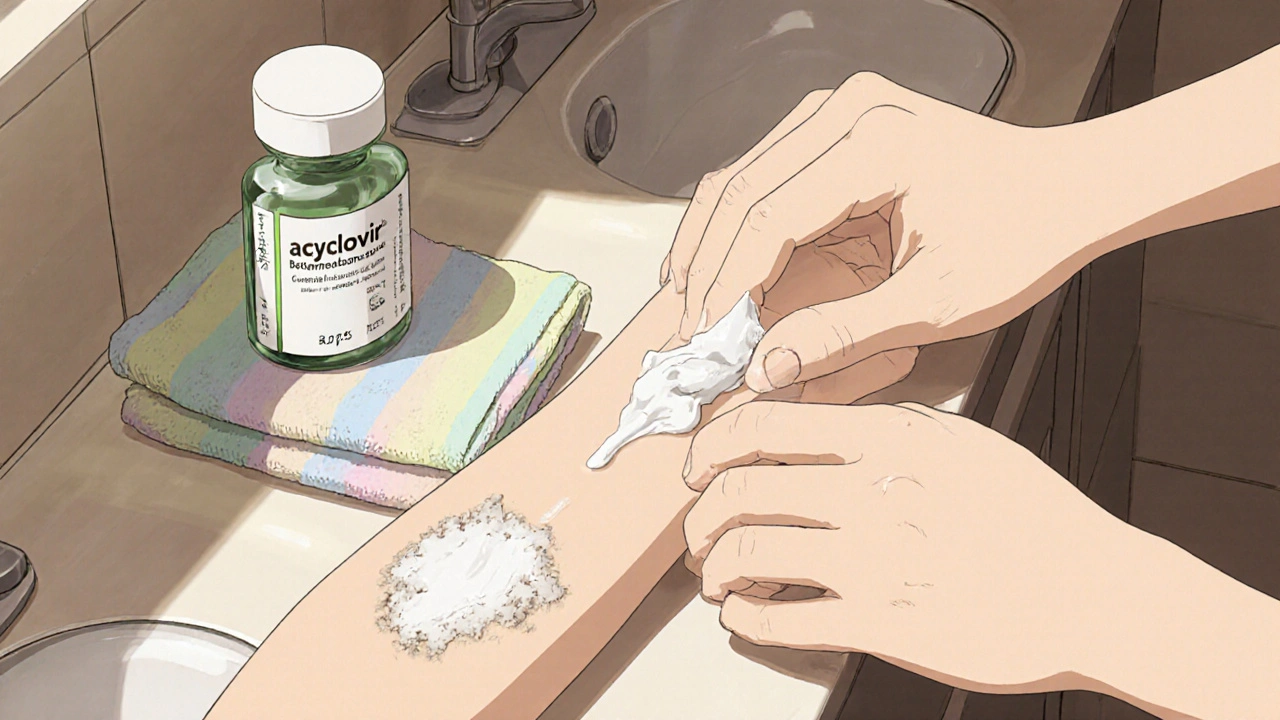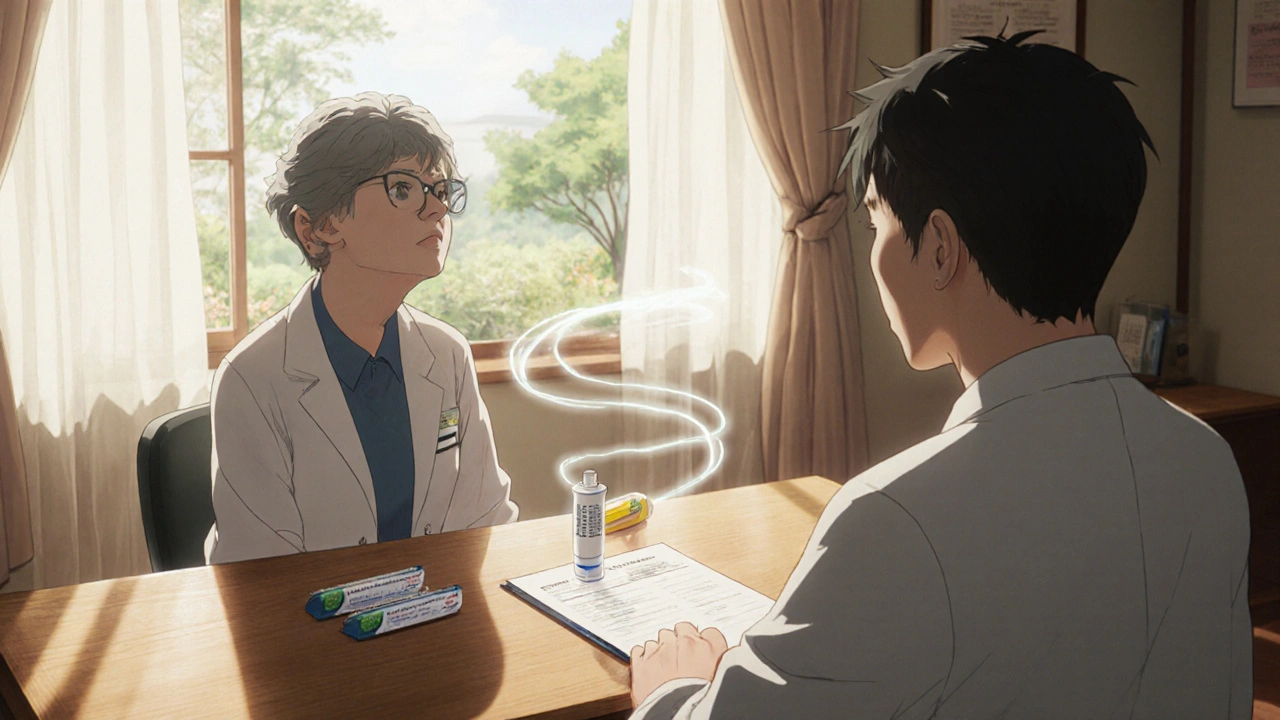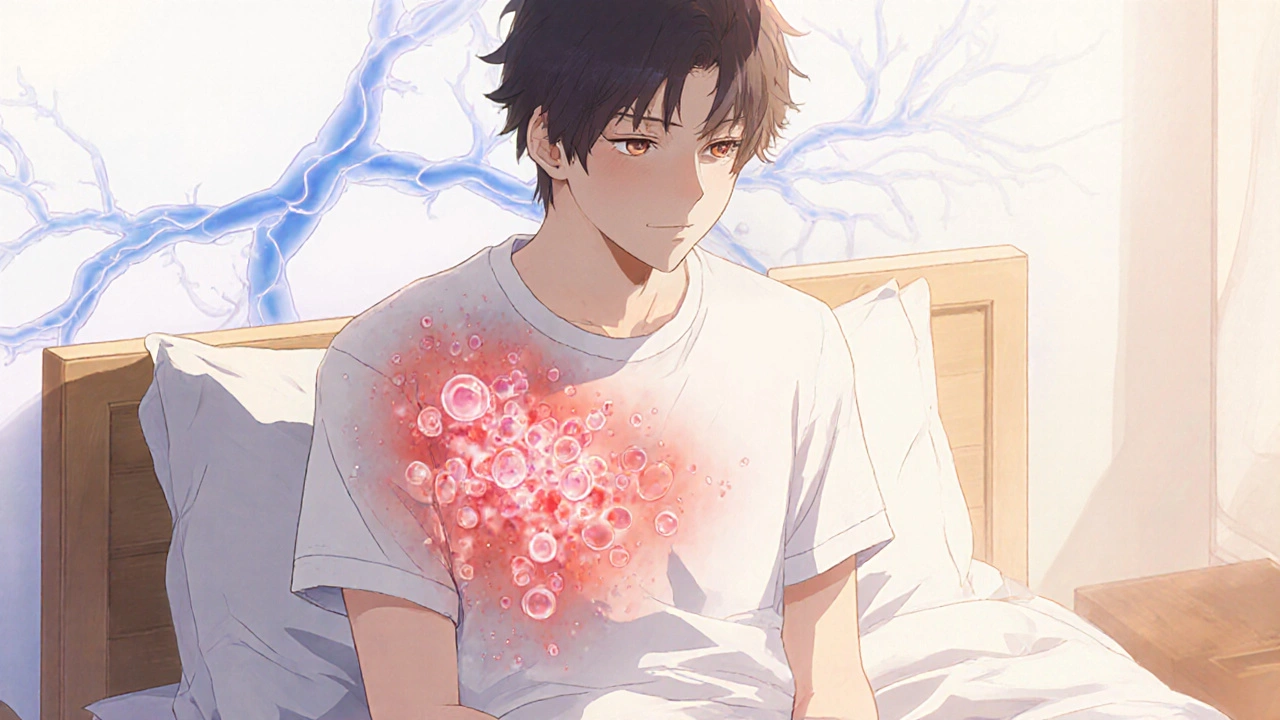Shingles Treatment Assessment Tool
Shingles Treatment Assessment
This tool helps evaluate if betamethasone steroid cream is appropriate for your shingles treatment based on your specific situation. Remember: steroids don't treat the virus, only inflammation. Use only as part of a comprehensive treatment plan with antivirals.
Treatment Recommendation
Potential Benefits
Potential Risks
Recommended Duration
Important: Always discuss with your healthcare provider before starting or stopping any treatment. This tool provides general guidance but not medical advice.
Key Takeaways
- Shingles is caused by the reactivation of the varicella‑zoster virus and is usually treated with antivirals.
- Betamethasone is a potent corticosteroid that reduces inflammation but does not fight the virus.
- Evidence shows steroids may speed rash healing but can increase the risk of complications if used alone.
- Combining a short course of betamethasone with standard antivirals is sometimes considered for severe cases.
- Always weigh the benefits against side‑effects like skin thinning and delayed viral clearance.
When a painful, blistering rash flashes across the torso, the first thought is often "shingles". The next question from a patient might be, "Can I use the steroid cream my doctor gave me for eczema?" That’s where Betamethasone is a synthetic corticosteroid known for strong anti‑inflammatory action enters the conversation.
What Is Shingles?
Shingles is a viral infection caused by the reactivation of the varicella‑zoster virus (VZV), the same virus that causes chickenpox. After the initial chicken‑pox illness, VZV lies dormant in nerve ganglia. Years-or even decades-later, a weakened immune system can let the virus awaken, traveling along sensory nerves to the skin and producing a painful, dermatomal rash.
Typical symptoms include:
- A burning or tingling sensation (prodrome) before the rash appears.
- Grouped vesicles that follow a nerve pathway.
- Fever, headache, and fatigue in some cases.
Complications can be severe. Up to 20 % of patients develop postherpetic neuralgia, a chronic nerve pain that may last months or years after the rash clears.
Understanding Betamethasone
Betamethasone belongs to the broader class of corticosteroids, which mimic the body’s natural cortisol hormone. Their primary actions are:
- Suppressing immune‑cell activity.
- Reducing the production of inflammatory mediators like prostaglandins.
Topical forms (cream, ointment, lotion) are used for skin conditions such as eczema, psoriasis, and allergic reactions. Systemic forms (oral tablets, injections) treat severe asthma, autoimmune disorders, and allergic reactions.
Standard Shingles Treatment
The gold‑standard for acute shingles is antiviral therapy, started within 72 hours of rash onset. The most common agents are:
| Drug | Typical Dose | Route | Key Benefit |
|---|---|---|---|
| Acyclovir | 800 mg | Oral, 5×/day | Reduces viral replication |
| Valacyclovir | 1 g | Oral, 3×/day | Higher bioavailability |
| Famciclovir | 500 mg | Oral, 3×/day | Convenient dosing |
Analgesics (NSAIDs, opioids) and neuropathic pain agents (gabapentin, pregabalin, tricyclic antidepressants) are added to control acute pain and to try to prevent postherpetic neuralgia.

How Corticosteroids Work in Skin Infections
Corticosteroids like betamethasone reduce the visible redness, swelling, and itching by dampening the local immune response. In the context of a viral rash, this can:
- Make the rash look less severe.
- Potentially speed the resolution of skin lesions.
However, the same immune‑suppressing effect can also slow viral clearance, raising the theoretical risk of prolonged infection or secondary bacterial infection.
What Does the Research Say?
Multiple small‑scale trials have examined adding steroids to antiviral regimens. A 2022 meta‑analysis of 8 randomized controlled trials (total n≈1,200) found:
- Patients receiving a short‑course oral prednisone (a systemic corticosteroid) alongside antivirals healed their rash about 1‑2 days faster.
- Incidence of postherpetic neuralgia was modestly lower (≈15 % vs 20 % in control), but the difference was not statistically significant in most studies.
- Topical steroids, including betamethasone 0.05 % cream applied twice daily, reduced itching scores by ~30 % but did not affect overall healing time.
Importantly, none of the studies showed a dramatic increase in serious adverse events when steroids were limited to a 7‑day course. Yet, most trials excluded immunocompromised patients, who may be more vulnerable to steroid‑related complications.
Potential Risks of Using Betamethasone for Shingles
Even when used briefly, steroids carry side‑effects that matter:
- Skin thinning and atrophy-especially with potent formulations applied to thin skin areas.
- Delayed viral clearance, potentially extending the contagious period.
- Higher chance of bacterial superinfection (cellulitis) under the broken skin.
- Systemic absorption leading to elevated blood glucose, a concern for diabetics.
The FDA labels betamethasone for inflammatory skin conditions, not for viral infections.

Practical Guidance: When (and How) to Use Betamethasone in Shingles
Based on the evidence, most clinicians reserve steroids for specific scenarios:
- Severe inflammation-when swelling threatens nerve compression or causes extreme pain.
- Rapid aesthetic concerns-patients with visible facial shingles who need quick reduction of erythema.
- Adjunct to antivirals-always start antivirals first; if a steroid is added, keep it to a short 5‑7 day course.
Typical topical regimen (if chosen):
- Betamethasone 0.05 % cream or ointment.
- Apply thin layer to affected area twice daily.
- Do not use on open vesicles-apply only after lesions have crusted.
- Limit use to ≤7 days; discontinue earlier if irritation occurs.
For oral steroids, a low‑to‑moderate dose of prednisone (e.g., 40 mg daily) for 5‑7 days is sometimes prescribed alongside antivirals, but this practice should be individualized.
Bottom Line
Betamethasone can help alleviate the inflammatory component of shingles, but it does not treat the underlying virus. The safest approach is to combine a standard antiviral (acyclovir, valacyclovir, or famciclovir) with a brief, low‑dose steroid course only in selected patients. Always discuss the plan with a healthcare provider, especially if you have diabetes, are immunocompromised, or have a history of skin thinning.
Frequently Asked Questions
Can I use over‑the‑counter steroid creams for shingles?
OTC steroids are usually low‑potency (e.g., hydrocortisone 1 %). They provide minimal anti‑inflammatory benefit and are not recommended as the primary treatment for shingles. Prescription‑strength betamethasone may be considered under a doctor’s guidance.
Will betamethasone increase the risk of postherpetic neuralgia?
Current data do not show a clear increase in postherpetic neuralgia when steroids are used short‑term with antivirals. Some studies even suggest a modest reduction, but the evidence is not strong enough to change standard practice.
How long is a person contagious with shingles?
A person is contagious until all lesions have crusted over, usually about 7‑10 days after rash onset. Adding steroids does not shorten this period and may theoretically lengthen it if viral clearance is delayed.
Is there a vaccine that prevents shingles?
Yes. The recombinant zoster vaccine (Shingrix) is >90 % effective in adults 50 years and older and is now the preferred vaccine over the older live‑attenuated Zostavax.
Can betamethasone be used on facial shingles?
Facial skin is thinner and more prone to steroid‑induced atrophy. If a steroid is deemed necessary, a very low‑potency formulation and a short duration are advised, always under dermatologist supervision.


Shingles can be a painful reminder that our immune system has weakened over time. While betamethasone may soothe the inflammation, it doesn’t target the virus itself. Pairing it with an antiviral, as the article suggests, remains the safest route.
Do not let pride drive you to slather a potent steroid on a viral rash without medical guidance!
Your concern about uncontrolled steroid use is understandable; many patients fear the side‑effects they read about online. The key is balance-using a short course under doctor supervision can calm the skin’s fire without compromising viral clearance. Studies show that brief topical betamethasone reduces itching without markedly delaying healing. Still, each case should be individualized, especially for those with diabetes or weakened immunity.
From a cultural perspective, many communities still rely on home remedies for shingles, yet modern medicine offers proven antivirals. Adding a steroid cream can help with the visible redness, but only when prescribed. Keep the application thin and stop once the vesicles have crusted.
Great points, Andrew. If you’re coaching someone through a shingles flare, remind them to start antivirals within that 72‑hour window-time matters. When the doctor approves a steroid, use the lowest potency and the shortest duration; a thin layer twice daily for up to seven days is usually enough. Watch for signs of skin thinning or secondary infection, and encourage gentle skin care like cool compresses. Most importantly, keep the focus on pain control and preventing post‑herpetic neuralgia.
Honestly, I find it amusing how some people think they can outsmart the medical community with over‑the‑counter creams. In our great nation, we have access to top‑tier antivirals; why gamble with a steroid that could thin your skin? Use what the experts prescribe and save the DIY experiments for weekend projects.
Your assertion overlooks the nuanced evidence presented in recent meta‑analyses, which indicate that a limited course of topical betamethasone, when combined with antivirals, may modestly reduce pruritus without significantly increasing adverse events. However, it is crucial to stress that such adjunct therapy is contraindicated in immunocompromised patients, as the immunosuppressive effect can exacerbate viral replication. The FDA’s labeling explicitly restricts betamethasone to inflammatory dermatoses, not viral infections, underscoring the need for professional oversight. Consequently, indiscriminate use, as you describe, is both medically unsound and ethically problematic.
Reading through the extensive review, one cannot help but notice the delicate balance between therapeutic benefit and potential risk that each clinician must weigh. Steroids, by virtue of their anti‑inflammatory power, offer immediate visual relief, which many patients cherish as a sign of progress. Yet, the very mechanism that calms inflammation also dampens local immune defenses, a fact that can prolong viral shedding. Clinical guidelines therefore advise initiating antiviral therapy promptly, ideally within the first three days of rash appearance, to curb replication. If a clinician deems a steroid necessary-perhaps due to severe edema compressing a nerve- the recommendation is a short, low‑dose regimen, not a prolonged course. Topical betamethasone 0.05 % applied sparingly, twice daily, for no more than seven days, has been shown to lower itch scores by about thirty percent without markedly delaying healing. Systemic steroids, such as a brief prednisone taper, may accelerate rash resolution by one to two days, but the evidence for reducing post‑herpetic neuralgia remains inconclusive. Patients with diabetes must monitor blood glucose closely, as systemic absorption-even from potent topical forms-can precipitate hyperglycemia. Equally important is vigilance for secondary bacterial infection; any new erythema, warmth, or purulent discharge warrants immediate medical attention. The immunocompromised population-those on chemotherapy, HIV‑positive individuals, or transplant recipients-should generally avoid steroid adjuncts unless absolutely indicated. Vaccination with Shingrix has dramatically lowered the incidence of shingles and, by extension, the need for such complex therapeutic decisions. Educational outreach that emphasizes early antiviral use can reduce both the duration of contagion and the likelihood of chronic neuropathic pain. Moreover, clinicians should counsel patients that the contagious period persists until all lesions have crusted, typically seven to ten days, regardless of steroid use. In practice, a shared decision‑making approach-discussing benefits, risks, and patient preferences-yields the most satisfactory outcomes. Ultimately, while betamethasone can be a useful adjunct, it is never a substitute for antiviral therapy, and its application must be judicious, evidence‑based, and closely supervised.